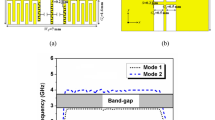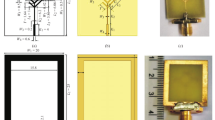Abstract
The outlining and design of a dual-band planar monopole antenna is presented in this work. A novel structured monopole antenna is designed and analyzed for dual-band applications. The proposed work covered dual circularly polarization (CP) bands along with broad impedance bandwidth (IBW). The designed antenna consists of a half-moon, full moon slotted rectangular modified radiator with partial ground plane. By fine-tuning, the slot size and ground plane with desired CP radiation are found at desired impedance bandwidth. The physical dimension of the antenna is given by \(0.49\lambda_{0} \times 0.40\lambda_{0} \times 0.02\lambda_{0}\). The −10 dB IBW is 11.01 GHz (3.59–14.6 GHz) with center frequency of 9.1 GHz having parentage of IBW 121.05% is conformed. The dual 3 dB axial ratio bandwidth (ARBW) of 2.24 GHz (3.65–5.89 GHz) and 0.7 GHz (9.05–9.75 GHz) are achieved. The proposed antenna is very simple to design, and it can be applied for 5G application, S-band radar, and maritime radio navigation.
Access provided by Autonomous University of Puebla. Download conference paper PDF
Similar content being viewed by others
Keywords
1 Introduction
Printed microstrip patch radiator is largely used in different communication application over the last decades of years due to easy fabrication process, its compact size, and lightweight in structure. However, for multiband application, planar monopole antenna made its own space in couple of years during this modern era of communication [1]. Nevertheless, circularly polarized planar monopole antenna shows a great participation in today’s communication system because of its advantages like overcoming from polarization mismatch, multipath reflection problem, and weak weather penetration power [2]. However, the problems in circularly polarized planar monopole antenna (CPMA) are large in size and small axial ratio bandwidth. Therefore, various types of technique are used [3,4,5,6,7,8,9,10,11,12,13,14] to improve size and ARBW. In this paper, all above factors are aimed to improve. A dual-band ARBW under a broad IBW with an average gain circularly polarized monopole antenna is implemented. A simple half-moon and full moon slotted along with triangular etched rectangular radiator is proposed. A simple microstrip line feeding is used asymmetrically to the radiator to improve ARBW. The details description of proposed structure, design procedures, and response are portrayed.
2 Antenna Design and Analysis
The design details and the values of length and width of physical parameter are mentioned in Fig. 1. The physical antenna consists of a thin cupper radiator with a microstrip feed, substrate, and partial ground plane from top to down with respect to Z-axis as shown in Fig. 1. Here, substrate is taken as FR-4 dielectric material whose loss tangent is 0.024 and permittivity is 4.4. In this design, length (L) and width (W) are taken in Y-axis and X-axis, respectively. The physical dimension of antenna is 29 × 31 × 1.6 (L × W × h) in millimeter. A full moon and half-moon-shaped slots are inserted inside the rectangular patch along with triangular-shaped cut at the right side of the radiator to improve IBW and ARBW. The position of microstrip feed line is asymmetrically connected and optimized to improve ARBW. By optimizing different parameters, ARBW and IBW are resulted. Final parameters are summarized in Table 1. The ANSYS HFSS (ver.15) is used to design and simulation of the designed antenna.
To get the final proposed antenna, four design steps are introduced from Ant.1 to Ant.4 (proposed) which are explained in Fig. 2. The details response of each steps are analyzed in Fig. 3.
To generate CP radiation, the horizontal and vertical component of electrical field should have equal magnitude and 90° phase difference. In Ant.1, very narrow −10 dB IBW is found at a resonant frequency of 10.46 GHz without any CP radiation in Fig. 3. However, IBW is improved largely up to 11.34 GHz and AR approaches toward 3 dB. In next step (Ant.3), IBW is further improved along with dual bands of CP radiation in Fig. 3. Finally, optimized dual band is found in proposed antenna (Ant.4) along with broad IBW. The 1st resonant frequency (\(f_{0}\)) of proposed antenna is found at 4.39 GHz, which is shown in Fig. 3, and its corresponding wavelength is \(\lambda_{0}\) (1st resonant wavelength).
2.1 Surface Current Analysis to Interpret CP Radiation
The resultant current direction can be determined from the figure of surface current distribution. From that resultant current direction, circular polarization characteristic can be verified by orthogonal orientation of phase angles. Figure 4 shows that surface current directions at 4.39 GHz for orthogonal phase angles 0° and 90°. By summing all the current vectors, the resultant current direction is found in a particular direction. All horizontal currents are canceled due to opposite direction of currents and only current is flowing in vertical up direction as shown in Fig. 4a. However, Fig. 4b shows that all verticals currents are canceled due to opposite direction of currents and only current is flowing in horizontal (right to left) direction. From Fig. 4, it is clearly shown that the current distribution oriented counter clockwise direction. From which, it is confirmed that it provides the right hand circularly polarized (RHCP) radiation in broadside direction and left hand circularly polarized (LHCP) radiation in backside direction.
3 Results and Discussion
The results of different characteristic parameters of designed antenna are displayed in Figs. 5 and 6. The IBW of CPMA is from 3.59 to 14.6 GHz confirmed in Fig. 5a. The dual band of ARBW is from 3.65 to 5.89 GHz and from 9.05 to 9.75 GHz are verified in Fig. 5b. The peak gain is found as 4.3 dBi, and average efficiency is more than 90%, which are displayed in Fig. 5c and d.
The far field radiation patterns of the proposed antenna are illustrated in Fig. 6. The YOZ plane and XOZ plane radiation patterns are plotted for variation of angle \(\theta\) at 4.39, 9.45 GHz to verify the circular polarization in two different CP bands. In both frequency, RHCP and LHCP waves are radiated toward broadside and backside directions, respectively.
4 Conclusion
A dual-band circularly polarized planar monopole antenna is implemented with very large IBW. Multiple number of slots are inserted to the rectangular radiator to optimize the ARBW and IBW. The IBW of CPMA is 121.05% (3.59–14.6 GHz) achieved. The dual ARBW of 2.24 GHz (3.65–5.89 GHz) and 0.7 GHz (9.05–9.75 GHz) are achieved. The proposed antenna can be used for different wireless communication like 5G application, S-band radar, and maritime radio navigation.
References
Lin CI, Wong KL (2007) Printed monopole slot antenna for internal multiband mobile phone antenna. IEEE Trans Antennas Propag 55(12):3690–3697
Gao SS, Luo Q, Zhu F (2013) Circularly polarized antennas. Wiley-IEEE Press, New York
Liu WC, Kao PC (2007) Design of a probe-fed H-shaped microstrip antenna for circular polarization. J Electromagn Waves Appl 21(7):857–864
Ghobadi A, Dehmollaian M (2012) Printed circularly polarized y-shaped monopole antenna. IEEE Antennas Wirel Propag Lett 11:22–25
Zhou SW, Li PH, Wang Y, Feng WH, Liu ZQ (2011) A CPW-fed broadband circularly polarized regular-hexagonal slot antenna with l-shape monopole. IEEE Antennas Wirel Propag Lett 10:1182–1185
Ding K, Gao C, Yu T, Qu D (2014) Broadband C-shaped circularly polarized monopole antenna. IEEE Trans Antennas Propag 63(2):785–790
Samsuzzaman M, Islam MT, Singh MJ (2018) A compact printed monopole antenna with wideband circular polarization. IEEE Access 6:54713–54725
Han RC, Zhong SS (2016) Broadband circularly polarized chifre-shaped monopole antenna with asymmetric feed. Electron Lett 52(4):256–258
Wu JW, Ke JY, Jou CF, Wang CJ (2010) Microstrip-fed broadband circularly polarized monopole antenna. IET Microwaves Antennas Propag 4(4):518–525
Le TT, Park HC (2014) Very simple circularly polarised printed patch antenna with enhanced bandwidth. Electron Lett 50(25):1896–1898
Nasimuddin BH, Shen Z (2015) Broadband circularly polarized moon-shaped monopole antenna. Microwave Opt Technol Lett 57(5):1135–1139
Cai YM, Li K, Yin YZY, Hu W (2014) Broadband circularly polarized Printed antenna with branched microstrip feed. IEEE Antennas Wirel Propag Lett 13:674–677
Ullah U, Koziel S (2019) A novel coplanar-strip-based excitation technique for design of broadband circularly polarization antennas with wide 3 dB axial ratio beam width. IEEE Trans Antennas Propag 67(6):4224–4229
Omar AA, Shen Z (2019) A compact and wideband vertically polarized monopole antenna. IEEE Trans Antennas Propag 67:626–631
Author information
Authors and Affiliations
Corresponding author
Editor information
Editors and Affiliations
Rights and permissions
Copyright information
© 2024 The Author(s), under exclusive license to Springer Nature Singapore Pte Ltd.
About this paper
Cite this paper
Barik, D.K., Azharuddin, M., Mondal, K., Murmu, L., Mandal, T. (2024). A Dual-Band Circularly Polarized with Large Impedance Bandwidth Planar Monopole Antenna for Wireless Application. In: Swain, B.P., Dixit, U.S. (eds) Recent Advances in Electrical and Electronic Engineering. ICSTE 2023. Lecture Notes in Electrical Engineering, vol 1071. Springer, Singapore. https://doi.org/10.1007/978-981-99-4713-3_26
Download citation
DOI: https://doi.org/10.1007/978-981-99-4713-3_26
Published:
Publisher Name: Springer, Singapore
Print ISBN: 978-981-99-4712-6
Online ISBN: 978-981-99-4713-3
eBook Packages: EngineeringEngineering (R0)











